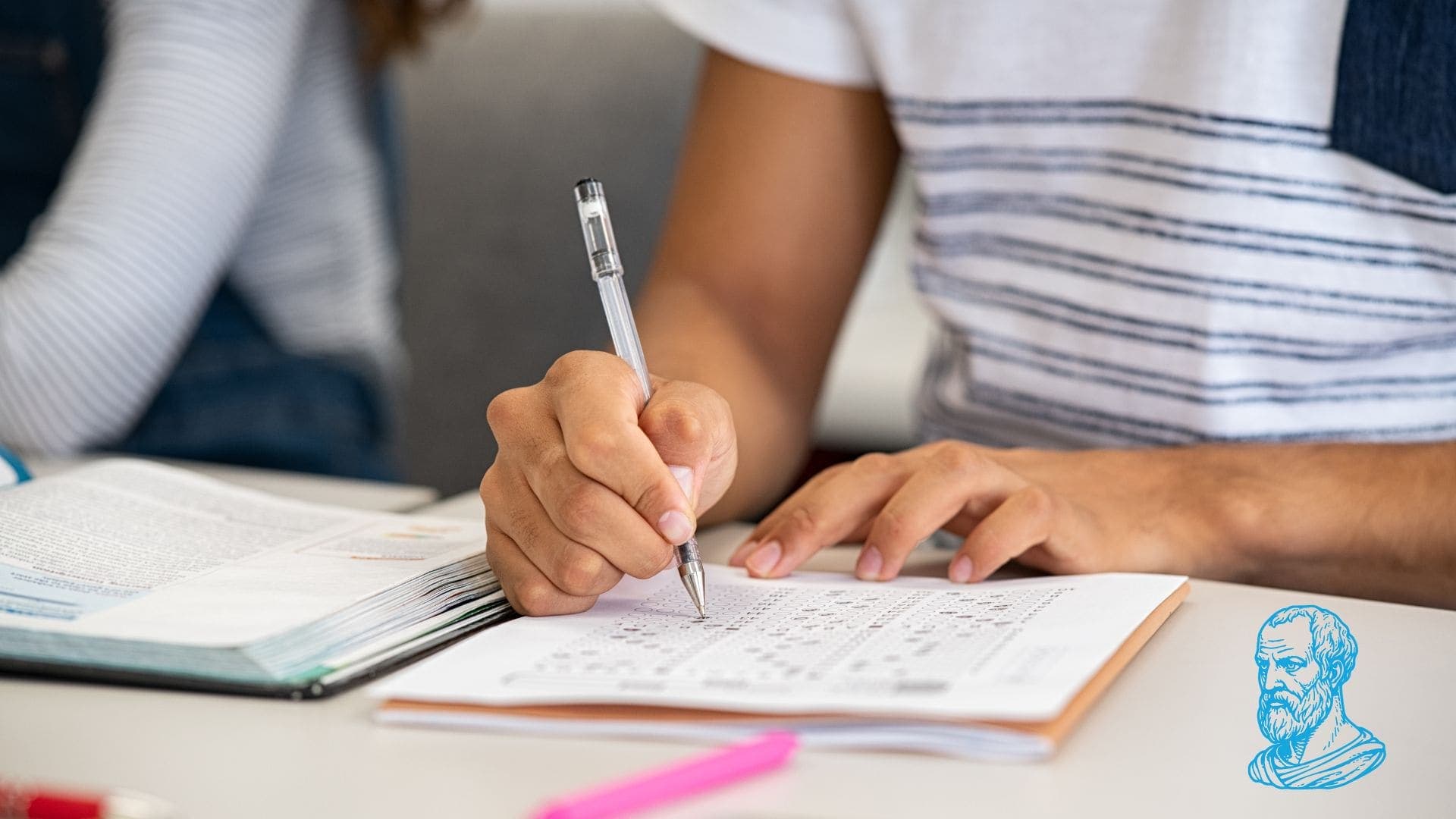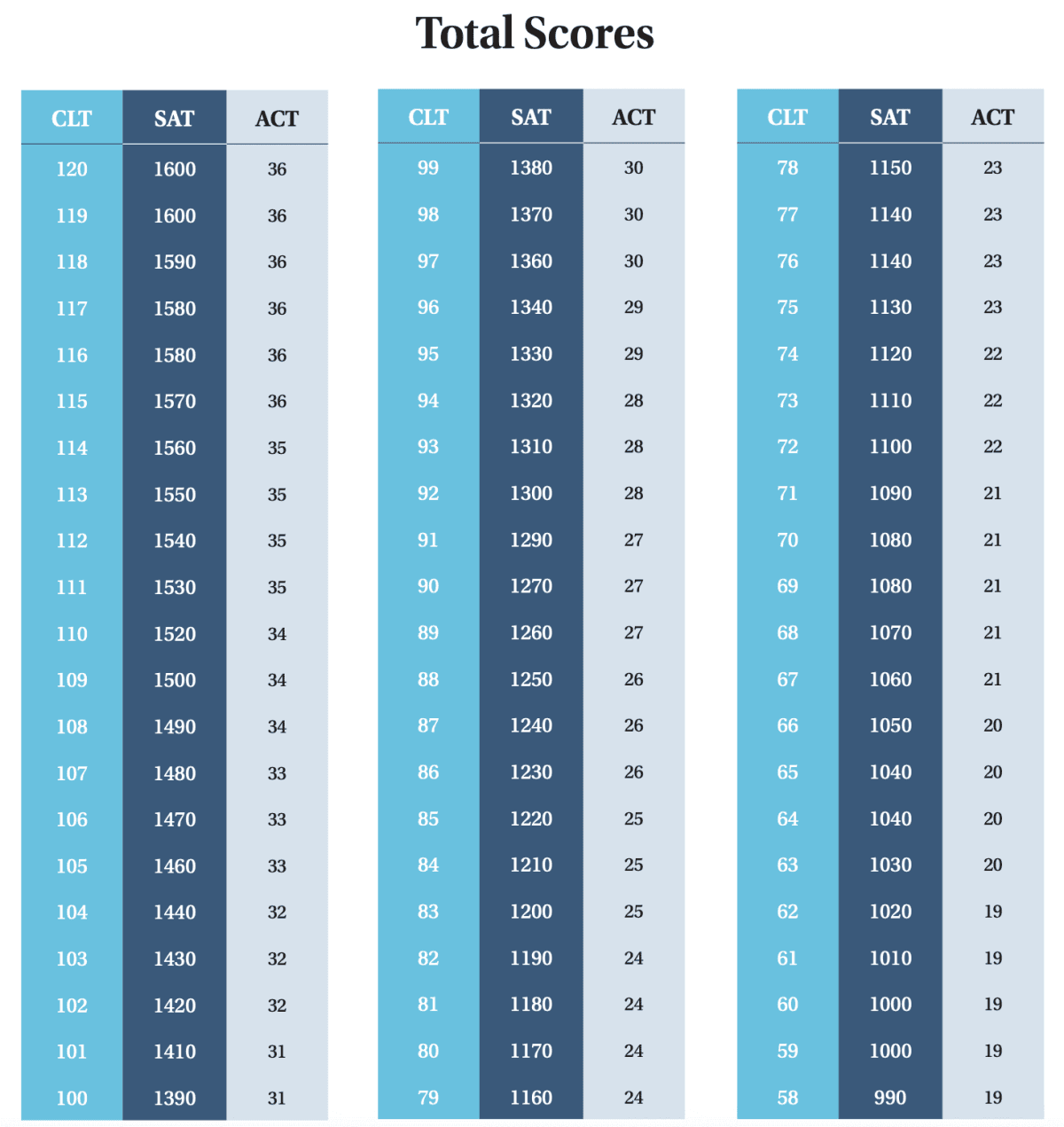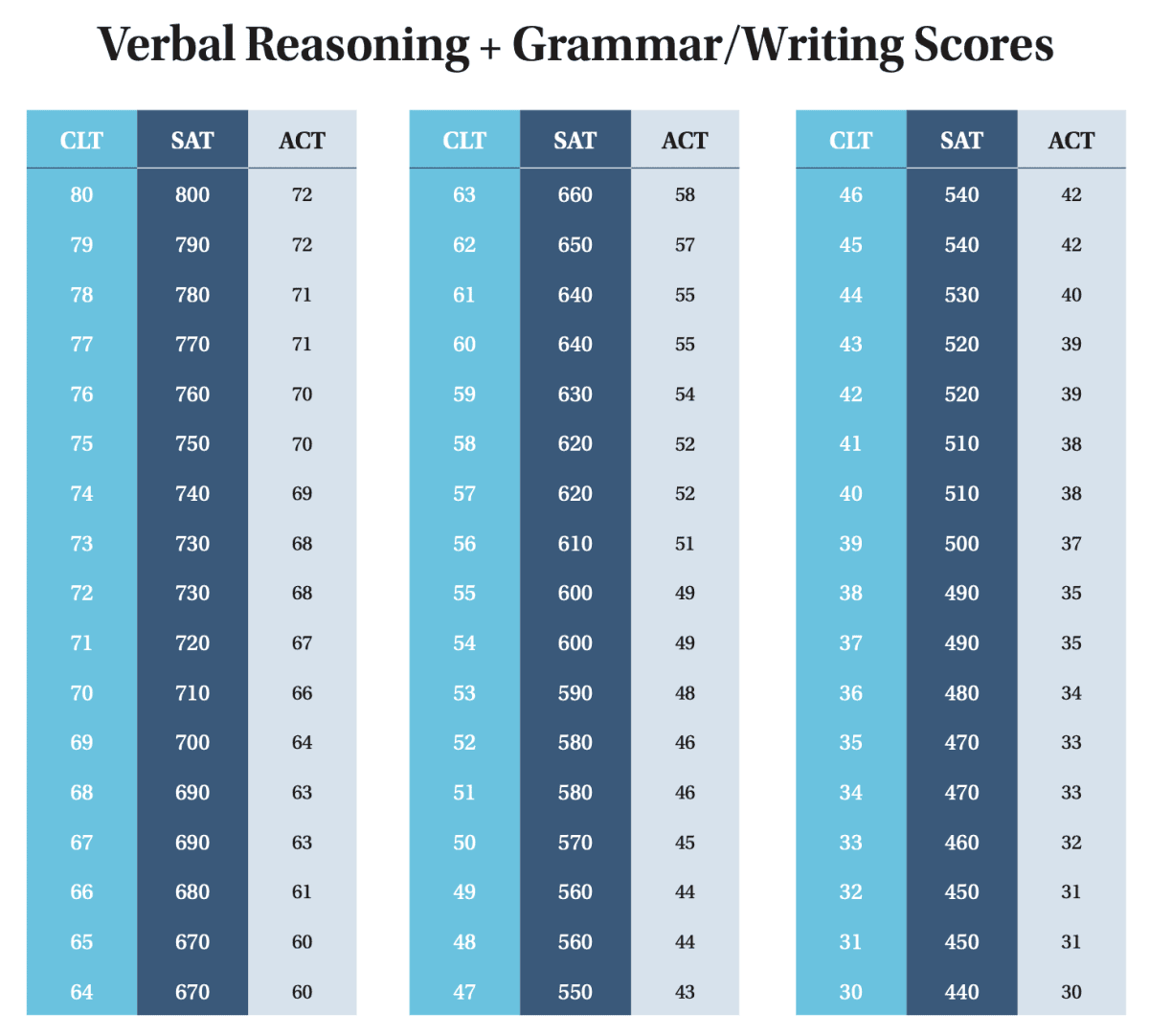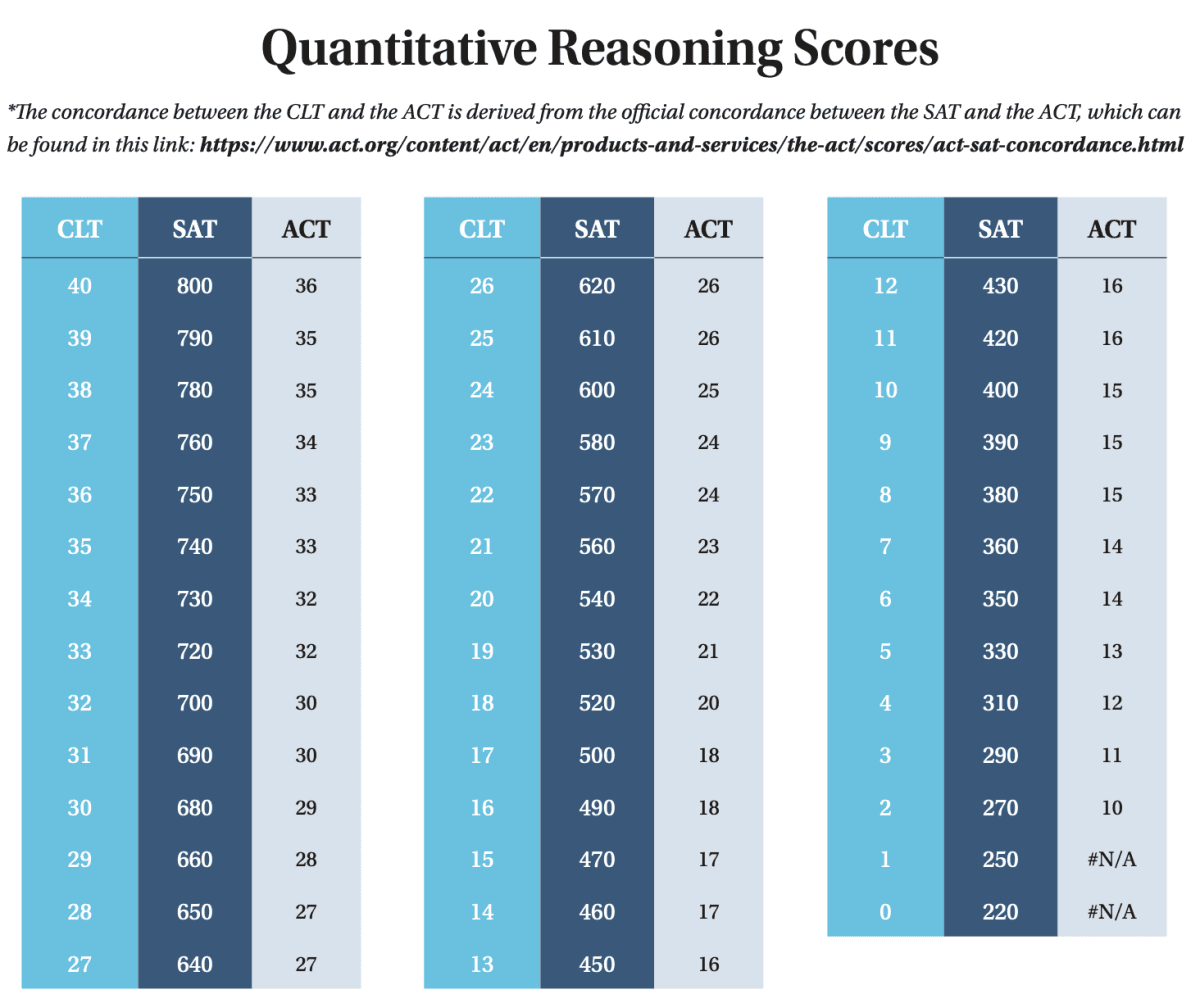
The Classic Learning Test (CLT), also known as the CLT exam, is a standardized test designed to assess students’ knowledge of the classical liberal arts. It is considered an alternative to the SAT and ACT tests, which are both very popular undergraduate admissions exams for American colleges and universities. The CLT sets itself apart with its focus on the study of history, literature, philosophy, and mathematics. The CLT is divided into three sections: Verbal Reasoning, Grammar & Writing, and Quantitative Reasoning.
This complete guide gives you an overview of the Classic Learning Test (CLT), the differences between the CLT and the SAT and ACT tests, CLT test structure, how to compare CLT scores with SAT and ACT scores, and effective CLT preparation strategies. This guide also covers which colleges accept the CLT and other logistical details. Let’s dig in.

The Classic Learning Test (CLT) emerges as a unique alternative to the commonly used SAT and ACT college entrance exams. Its mission prioritizes a well-rounded education rooted in classical literature and critical thinking skills, appealing particularly to religious schools. However, it’s important to emphasize that the CLT itself is not religiously or politically affiliated, nor does it contain any religious content.
The CLT offers four different standardized tests:
For the purpose of the article we will focus on CLT (for 11th and 12th graders) and how it used to replace or supplement the popular standardized tests (SAT and ACT).
The CLT departs from the traditional SAT and ACT in several key ways. Let’s go over the differences in the content, scoring, and other factors.
Why schools and students are choosing the CLT?
CLT diverges from the SAT and ACT by testing on critical thinking through engagement with classic texts, emphasizing historical and philosophical perspectives alongside traditional reading comprehension. This resonates with schools seeking students who can analyze complex ideas and engage with diverse viewpoints, valuing critical thinking over solely technical skills. The CLT’s focus on timeless literature and argumentation complements a well-rounded education, aligning well with institutions seeking students with strong foundational knowledge and a love of learning.
Imagine two paths to college readiness: one bustling with formulas and equations, the other composed of ancient wisdom and thought-provoking narratives. That’s the difference between the familiar SAT and ACT, and the emerging CLT.
The CLT takes a refreshing detour from the traditional focus on math and science. Instead, it invites students to explore the rich world of classical literature and Western philosophy. The test is all about critical thinking, close reading, and understanding the big ideas that have shaped our world.
Schools like this approach for many reasons. First, it goes beyond memorizing facts and formulas. The CLT encourages students to grapple with complex concepts, analyze arguments, and develop their own perspectives. Second, it exposes students to a diverse range of literature, history, and philosophy, enriching their understanding of the world and themselves. Third, CLT’s focus on critical thinking and communication skills builds a solid foundation for success, not just in college but in all aspects of life.
Think of it like this: while the SAT and ACT prepare you for the technical aspects of college, the CLT equips you with the critical thinking and communication skills that will be invaluable throughout your entire life. It’s not just about getting into college, it’s about becoming a well-rounded, thoughtful individual ready to engage with the world around you.
While the SAT and ACT prioritize math skills and science knowledge, the CLT tests on classical literature and Western philosophy. Critical reading is tested on all three exams, but unlike the SAT and ACT, the CLT critical reading questions demand thoughtful analysis of thought-provoking texts from authors like Plato, Dante, and Austen. Grammar and logic are also a big part of the CLT exam, requiring students to not only analyze sentences but also build connections between ideas. This approach reflects an emphasis on philosophy. Whereas the SAT and ACT often focus on rapid calculation and test-taking tactics, the CLT tests on critical thinking and encourages students to build a strong intellectual foundation.
The scoring systems of CLT, SAT, and ACT differ in many ways.
CLT uses a scale from 40 to 120, with 114 roughly equivalent to a perfect score. This composite score is a combination of the three section scores that each use a scale from 1 to 40: Verbal Reasoning, Grammar & Writing, and Quantitative Reasoning.
SAT uses a scale from 400 to 1600. This composite score is a combination of two section scores that each use a scale from 200 to 800: Evidence-based Reading and Writing, and Math.
ACT uses a scale from 1 to 36. This composite score is an average of the four section scores that each use a scale from 1 to 36: English, Math, Reading, and Science.
While CLT emphasizes classical texts and higher-order thinking, SAT focuses on reading comprehension and analytical skills, and ACT assesses subjects similar to SAT but includes focus on science, testing critical thinking and problem-solving within scientific contexts.

This section will cover the CLT’s inner workings, exploring each major content area and shedding light on its duration, cost, and potential challenges.
The Classic Learning Test (CLT) is broken into three major content areas:
Verbal Reasoning
Grammar & Writing
Quantitative Reasoning
The Verbal Reasoning section tests your ability to analyze and synthesize diverse texts through comprehension, contextual vocabulary, author’s intent, structure, and logical inference.
This section (40 questions) assesses your ability to analyze and synthesize diverse texts (Literature, Science, Philosophy/Religion, History/Documents) through comprehension, vocabulary, author’s intent, structure, and inference. Expect 27 comprehension questions and 13 analysis questions.
Comprehension questions test you on passage structure, main ideas, and supporting details, demanding attentive reading and inference skills.
Analysis questions test you on rhetorical devices, authorial intent, and relationships between texts, evaluating your ability to think critically about what you read.
The Grammar & Writing section evaluates their ability to identify and correct grammatical errors, compose well-structured sentences and paragraphs, and effectively communicate their ideas.
This section (40 questions) assesses your ability to refine and enhance written text. 20 questions focus on grammar, covering areas like agreement, punctuation, and structure, while 20 focus on writing, evaluating clarity, flow, and word choice. Passages cover diverse topics across philosophy/religion, historical profiles, and science,ensuring well-rounded skill assessment.
Grammar questions test you on spotting punctuation errors, subject-verb agreement issues, and sentence structure mistakes, showcasing your knowledge of proper grammar.
Writing questions test your ability to improve clarity of a sentence, conciseness, and word choice in provided passages, revealing your aptitude for effective written communication.
Finally, the Quantitative Reasoning section assesses your logical thinking, symbol manipulation, and spatial awareness.This section has three type of questions:
Algebra & geometry questions test you on equations, inequalities, and geometric figures, confirming your grasp of algebraic and geometric concepts.
Mathematical reasoning questions test you on logic puzzles, word problems, and data analysis await, evaluating your ability to apply math skills to real-world scenarios.
The CLT takes 2 hours and 20 minutes, with 2 hours devoted to testing and 20 minutes of breaks. This includes 40 minutes for Verbal Reasoning, 35 minutes for Grammar & Writing, and 45 minutes for Quantitative Reasoning.
Section | Duration |
|---|---|
Verbal Reasoning | 40 minutes |
Grammar & Writing | 35 minutes |
Quantitative Reasoning | 45 minutes |
Breaks | 20 minutes |
Total Test Time | 2 hours and 20 minutes |
The CLT Exam costs $69.
There are no additional registration/score fees, international tester fees, or sending score fees – a welcome reprieve from the practices of other test providers. There are no refunds for a missed test date, but it’s possible to register to a new date for no additional cost. To reschedule, visit the CLT rescheduling page.
This section we will explain CLT scores, compare them to the widely recognized SAT and ACT, and provide a comprehensive conversion chart to translate between these different scales.
CLT scores are reported on a scale of 1-120. However, as most people aren’t familiar with the ranges of CLT scores, it’s useful to compare them to the more familiar SAT and ACT scores. The conversion chart below offers a rough estimate of equivalence between scores on these different tests.

This chart above shows the comparison between CLT and SAT scores. For example, CLT score of 92 corresponds roughly to a 1300 on the SAT and a 28 on the ACT, while a CLT score of 101 aligns with a 1410 on the SAT and a 31 on the ACT.
Here are the concordance tables for CLT and ACT / SAT Verbal:

And Math:

Beyond numerical comparisons, the CLT assesses different skills and knowledge areas compared to the SAT and ACT. The CLT emphasizes a strong foundation in classical literature, grammar, and critical thinking, while the SAT and ACT focus more heavily on math and general reading comprehension. The direct score comparisons should be interpreted with caution and alongside other application materials.

One way to prepare for the CLT is to utilize the official CLT study guide, which provides comprehensive content review and practice tests. Prioritize regular practice with past CLT exams and other standardized test materials to familiarize yourself with the format and timing.
A general guideline for the CLT is that you should study for at least 2-3 months. As we mentioned before, dedicating time during school breaks (like summer or winter break) to prep is generally a good idea. You should expect to spend at least 100 hours studying, which over 8 weeks (2 months) is 12 hours per week, or over 12 weeks (3 months) is 8 hours per week. Be sure to schedule this study time in advance to ensure you leave space for it!
Naturally, the more you want to increase your score, the more that you should expect to need to study. If you want to improve your CTL score by 10 points or more, then six months of dedicated studying is recommended.
The Classic Learning Test (CLT) is administered on multiple dates throughout the year.
Testing Date | Registration Deadline | Testing Format | Score Release Date |
|---|---|---|---|
January 27th, 2024 | January 16th, 2024 | Remotely Proctored
| February 6th, 2024 |
January 27th, 2024 | December 20th, 2023 | Online | January 30th, 2024
|
February 15th, 2024 | For Paper – January 5th 2024
For Online – January 19th 2024
| Online, Paper
| February 20th, 2024 |
February 15th, 2024 | February 7th, 2024 | Remotely Proctored | February 27th, 2024 |
March 16th, 2024 | March 6th, 2024 | Remotely Proctored | March 26th, 2024 |
March 16th, 2024 | February 16th, 2024 | Online | March 19th, 2024 |
April 11th, 2024 | April 2nd, 2024 | Remotely Proctored | April 23th, 2024 |
April 11th, 2024 | March 15th, 2024 | Online | April 16th, 2024
|
April 24th, 2024 | For Paper: March 13th, 2023
For Online: March 29th, 2024
| Online, Paper | April 30th, 2024 |
May 11th, 2024 | April 30th, 2024 | Remotely Proctored | May 21st, 2024 |
June 20th, 2024
| June 7th, 2024
| Remotely Proctored | July 7th, 2024 |
Source: CLTExam.com | |||
Be sure to leave enough time for studying before your scheduled test date!

Taking the CLT is the first step towards showcasing your academic strengths and achieving your college admissions goals. Here’s a simple guide to navigate the registration process and ensure a smooth testing experience.
First, you have to sign up. Here’s a step by step guide on how to register for the CLT:
That’s it! Once you complete your registration, you’ll be all set to take the CLT exam!
The CLT exam does not have explicit requirements for what you bring to a CLT test day for the paper exam. Therefore, we recommend that you bring what is typical for the ACT or SAT:
If you are taking the CLT on a computer, whether at school or at home, they recommend you bring the following:
It is important to note that you must bring your own computer. This is different than the ACT and SAT, which often provide computers.
In addition to the official suggestions for the CLT exam on a computer, we recommend also adding the following from the previous suggestions:
With this, you should be all set to take the CLT!
Yes, the CLT offers online and at home testing throughout the year. See the CLT exam schedule in the CLT test dates section above or on their website.
A photo ID and a computer with a functioning camera and microphone are mandatory. Only laptops and desktops are required, but ensure a minimum upload speed of 2 MBPS for optimal performance.
Then, bring all of the materials that you would have brought to a computer CLT test at school (see above: “What to bring to your CLT test day”).
By fulfilling these requirements, test-takers can confidently take the CLT test at home.

After successfully completing the CLT, you can embark on the next chapter of applying to colleges. CLT scores are accepted by a diverse set of 250 colleges and universities that recognize its value as an alternative to the SAT or ACT.
As you begin your college applications, remember to carefully review the specific requirements of each institution you are interested in. While some colleges may accept the CLT alone, others may still require additional standardized testing or application materials. Researching each college’s unique preferences will ensure you submit a complete and competitive application package.
Depending on how you took the test, you can expect your CLT results to be available within 7-10 business days.
Scores for in-person CLT exams are typically released on the Tuesday following the testing date. However, for remotely proctored exams, additional review procedures take place, resulting in a slightly longer wait of two Tuesdays after the administration date.
Regardless of the format, you can generally expect to receive your electronic score report within 7-10 business days. Once you have your results, sending them to colleges is a simple process done through the CLT website (more on that below).
Once released, you can choose to share your CLT scores with any college you desire through your online student account on the CLT website. CLT provides a helpful tutorial video explaining the score-sharing process.
Unlike some other standardized tests, the CLT does not automatically share scores with any institutions. This allows you to make informed decisions about your academic future and strategically share your test scores with the colleges that best align your goals.